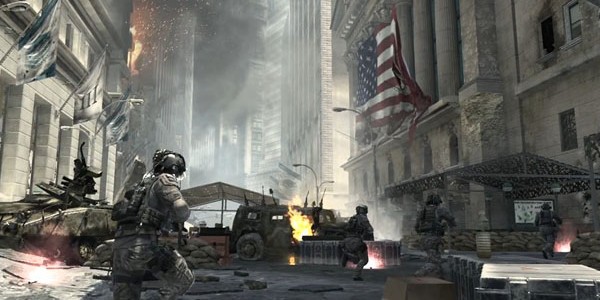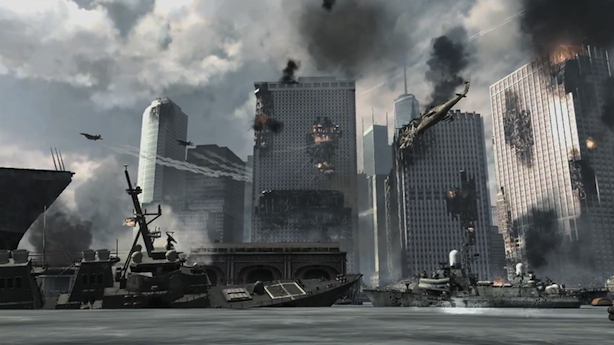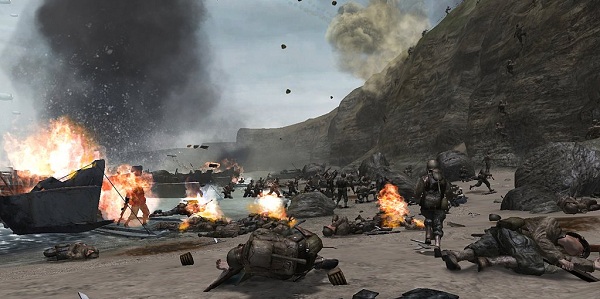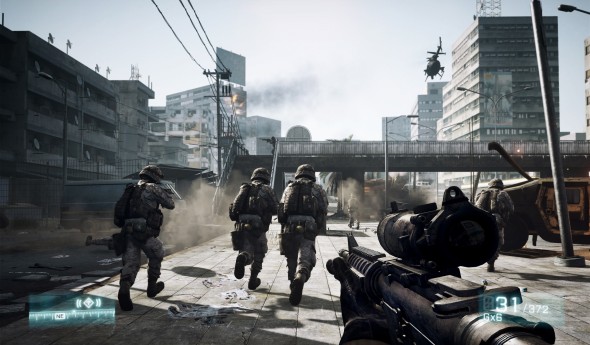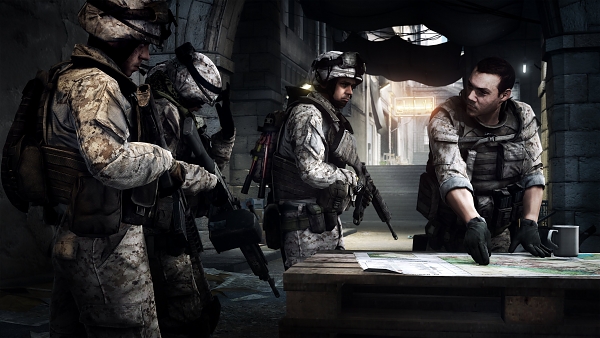Modern fictitious games of war go big with espionage, weapons of mass destruction, military coups, merciless dictators, and explosion-filled set pieces that would make Michael Bay blush. They employ elite squads of fearless, badass, bulletproof heroes in exotic military compounds – far from honest representations of the real, harrowing experiences of soldiers on the front lines of international conflict.
The misrepresentation is two-fold. As narrative is conveyed in and out of the overarching plot, any game’s attitude can be altered based on what happens around the player: setting, action, audio, level design, mechanics, surrounding characters, NPCs, and more. The atmospheric elements combine to create an ambiance that is crucial to capturing a true sense of life-and-death combat.
More often than not, modern military shooters capture “Iron Man” instead of “Restrepo”. In Modern Warfare 3, soldiers remain cool as members of their squad, their friends, are mowed down by jeep turret fire in the heart of New York City. There are no cries for the names of the soldiers; that would make the game too grounded. Their bodies all land face down, sparing you the vicarious heart-wrenching found in earlier first-person shooters – and in the same series, nonetheless.
Charging through a small portion of a village, having come from the cliffs that lead to the beaches of Normandy, my fellow Army Rangers and I had just witnessed our fellow soldiers burned alive in their transports and falling fatally to their deaths on the way up the cliffs. We come to the rear of a house that leads to a crucial road with access to guns firing on the beaches. As we get halfway through the yard, a German outfit ambushes our position. We take cover behind three-feet stone walls crumbling from the terrifying hail of bullets. My combat comrade stands to my right, shoulder to shoulder, as we lay into our enemies.
A grenade lands in front of the wall. I see it in time and lie prone, suffering minor shell shock. When I come to, I look right to see if my buddy has arisen to reengage the Germans. I’m met by his dead eyes, frozen in the terror of his final moment of life.
He didn’t duck the potato masher in time. It gives me time to reflect on how in World War II, this sort of thing happened regularly, especially at Normandy. I wondered, “How many of those actual soldiers had families: mothers, fathers, wives, daughters, sons.” It was a rare moment in gaming, a teaching moment. It reminded me that no matter how well-prepared a soldier was, death was always right around the corner. For all those who survived, there were many, many more that hadn’t.
I haven’t experienced that kind of emotional punch in a Call of Duty title since Modern Warfare. I felt it in the beginning of Battlefield 3; that sense faded by mid-campaign and soon became just like its rival franchise. Even in a poignant moment where, and let this be a spoiler warning right now for those who have not played the game, a pair of my character’s good friends and squad mates are torn up by a fighter jet’s missile, it failed.
In the real world, any jet killing a human being would leave quite the mangled bodies behind: missing limbs, large blood stains in the uniform, etc. But in this scene all that is seen are a few light blood streaks on the pavement. It felt staged and unrealistic. Not a truly graphic portrayal of what I should have witnessed and for that, the emotion of the scene suffered.
As Steven Spielberg said in an interview regarding his inclusion of graphic violence in “Saving Private Ryan”:
“It’s graphic because it’s what really happened. It’s a very, very honest recreation of the landing on 6 June 1944. I could have made ‘Saving Private Ryan’ a very safe picture; I could have done all the violence off-camera and I could have had people dying in slo-mo, like in the movies we go and see every summer. But my intention was to resensitise the audience.”
A major fault of Battlefield 3, every friendly death save one in the game occurs either off-screen or in slow motion. As Spielberg suggests, it is a means to glorify and desensitize the violence in order to make it feel more epic, sensational, which ultimately acts as a betrayal to reality. But even if the gore had been appropriately applied, the scene had already detracted all focus from the soldiers, the fear, and the humanity.
It’s the same situation in recent Call of Duty titles. With the plot being so over-the-top – elite squads of killing machines left as the only saviors to stop a nuclear crisis or end World War III – time and focus is taken off of what is the truly important tale: everyman soldiers put into extraordinary situations who just want to survive the mission or war with their sanity and friends intact.
Ask any survivor of war combat and you will undoubtedly discover that the biggest battles they ever faced weren’t physical but psychological. The struggle may have been caused by the external, but they wreaked havoc on the minds and mental well-being of soldiers. Imagine the toll one’s sanity takes watching helplessly as friends die around you for months, seeing the replacements die even faster, taking unmerciful shelling for days at a time, facing sudden attacks, heading into a battlefield where returning soldiers claim it cannot be won, and more.
Military shooter developers should take note of realistic depictions of modern combat scenarios. These can create scenes that grip the player and refuse to let go. Those can translate to character- and theme-building moments where soldiers contemplate the significance of God, agonize over a failure to keep the promises of deceased comrades, discuss the futility of their situation, or show a young man so filled with shock and terror that he is digging a foxhole with his bare hands (see: “Band of Brothers”). Done before or in-between battle segments, these can set the tone for a true-to-life and sobering experience.
But these aren’t the only emotions soldiers feel in the midst of war, as members of squads, companies, and units truly define the meaning of the phrase “brothers in arms.” Their experiences, both in and out of combat, bond them together like a family. It’s why when someone dies, their loss is felt so heavily by everyone. This is true for the elite and regular, old and modern. From Easy Company’s campaign in World War II (see: “We Stand Alone Together: The Men of Easy Company”) to Battle Company’s year-long deployment to the Korengal Valley in Afghanistan (see: “Restrepo”), veterans all share similar sentiments on battle and the comradery that develops from it.
These bonds need to be implemented and developed better in military shooters, and it isn’t an impossible feat. If games like Heavy Rain, Catherine, and L.A. Noire have shown anything, it’s that intelligent and thoughtful design can turn the mature, important, low-action moments of character- and plot-advancement into surprisingly engaging and interactive experiences that draw the player in. Placing and implementing this successfully into downtime at bases, during briefings, and during lulls in battle could deliver a massive shot in the arm to the genre’s narrative.
Film and television aren’t the only mediums that can create a truly authentic war story. If game designers and the people who play them want to claim that videogames can stand as an example of excellent storytelling, entertainment, and artistic creation, they should push to have the industry’s most lucrative titles strive to better themselves. Putting the focus back on those who sacrifice the most, the soldiers, would do just that. These games can do better. They should do better.




